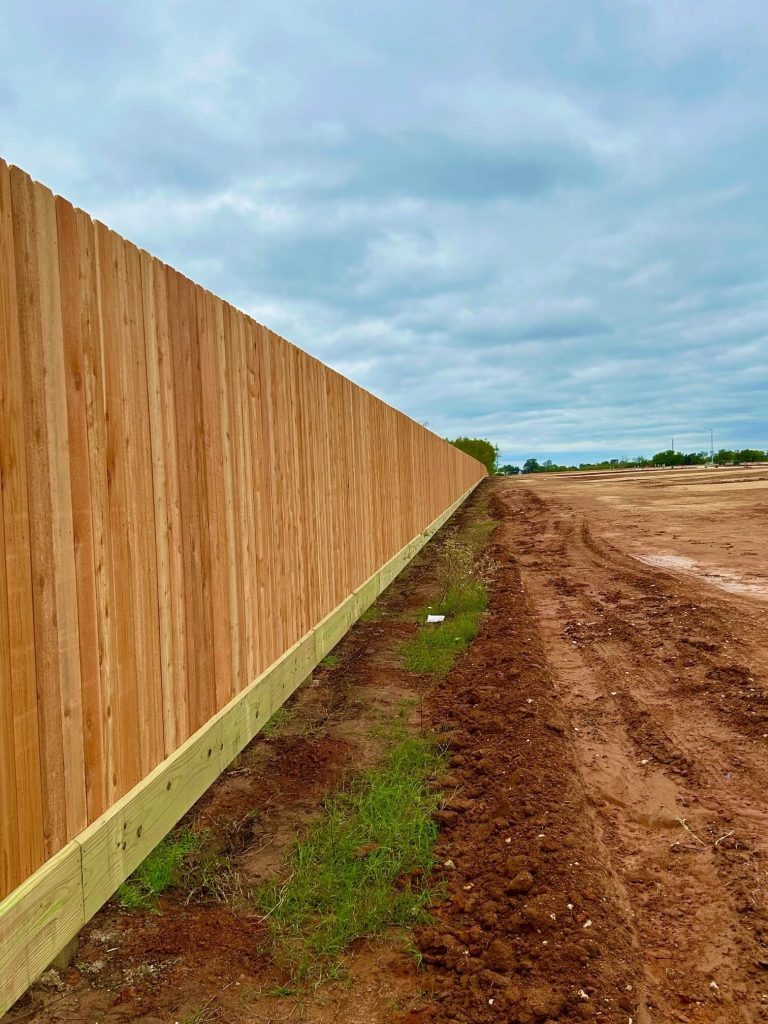Wooden Fencing: Installation, Types, and Maintenance Tips
Wooden fencing offers a timeless aesthetic, natural durability, and versatile customization options to enhance your property’s privacy and curb appeal. It can be stained or painted to match your desired look and is a popular choice for residential and commercial properties alike.
The Versatility of Wooden Fencing
Wooden fencing is a chameleon in the world of property design and landscaping. Its adaptability makes it suitable for a wide range of architectural styles and landscaping preferences. From classic picket fences to modern horizontal slat designs, there’s a wooden fence to match any vision or property type.
I’ve seen how a charming white picket fence can instantly enhance the curb appeal of a traditional suburban home, adding character and charm. On the other hand, sleek horizontal wooden fences offer a modern touch, blending seamlessly with contemporary urban residences. The beauty here lies in the flexibility that wood offers: it effortlessly adapts to various aesthetic preferences, making it an excellent choice for homeowners at both ends of the architectural spectrum.

Customization Options
But what truly sets wooden fencing apart is its customizability. Homeowners can transform their wooden fences through staining or painting in a diverse array of colors. This means you have free rein to create the perfect visual effect that complements your property’s aesthetic. Whether it’s a timeless natural wood finish or a bold pop of color to make a statement, the potential for customization is limitless.
Additionally, wooden fencing can be further personalized with decorative elements such as lattice tops, finials, and ornamental post caps that add a touch of elegance.
It’s this adaptability and versatility that makes wooden fencing such an appealing choice for homeowners looking to tailor their outdoor spaces to their unique tastes and preferences.
Furthermore, unlike other fencing types that may have limitations when it comes to customization, wooden fencing can easily be altered, expanded, or enhanced even after installation, providing long-term flexibility for your property needs.
Wooden fencing offers the perfect canvas for homeowners to express their individuality in their property design while maintaining a classic and timeless appeal.
Different Types of Wooden Fencing
Wooden fences come in a variety of styles, each with unique characteristics and functionalities. Understanding the different types can help you choose the right one for your property.
Privacy Fences: These are designed with closely spaced boards, offering maximum seclusion and creating a barrier that is ideal for backyard boundaries. If you want to create a private oasis in your backyard and keep prying eyes out, then a privacy fence is your best bet. We use these for clients who want their backyard to be their escape from the world—it makes it feel like you’re in your own little world back there.
Picket Fences: Known for their charming and welcoming appeal, picket fences are shorter in height and often used for front yards. They add a touch of traditional charm to any home and give it a warm, inviting feel. It’s like setting out a welcome mat for guests before they’ve even reached your door. Picket fences have been around for a long time because they just feel so cozy and nice.
Ranch Rail Fences: These fences feature horizontal rails and are popular for larger properties or rural areas. Ranch rail fences are often used for livestock enclosures but can also provide a rustic, country aesthetic to any property. The simplicity of the design gives off a peaceful, pastoral feel—perfect for anyone who loves living surrounded by nature.
Lattice Fences: Incorporating decorative lattice panels, these fences are perfect for adding a touch of elegance to garden spaces or outdoor areas. Lattice fences are as much about style as function—they offer a more refined look while still providing some privacy. The decorative lattice panel immediately adds an air of sophistication and can turn any garden into an elegant outdoor space.
Each type of wooden fencing has its own unique features and benefits, catering to different purposes and aesthetic preferences. Depending on your specific needs, you can opt for maximum privacy with a privacy fence, or if you want to maintain visibility while demarcating your boundary, picket or ranch rail fences might be more suitable.
Optimal Locations for Installing Wood Fences
Wooden fences have a natural warmth that complements various outdoor spaces. In residential properties, they excel in creating a sense of seclusion and security. Among the most effective uses for wooden fences is as a perimeter around your yard; they provide privacy and define property lines, helping to establish clear boundaries while maintaining an inviting aesthetic.
Moving beyond the perimeter, wood fences are fantastic for enclosing backyard spaces, offering a natural extension of your home. They provide a boundary for family gatherings, outdoor play, gardening areas, and much more. Think of them as the framework that defines your personal outdoor oasis.
In garden or pool areas, wooden fences add an element of charm and elegance while creating a safe enclosure. They seamlessly blend with the landscape and serve as protective barriers, offering peace of mind for families with children or pets.
Moreover, wooden fences are versatile in their ability to delineate various zones within your property. Outdoor living spaces benefit greatly from wooden fences as they create cozy nooks and help enhance the overall ambiance of the area. They can be used to define separate functional areas within your yard – a dining area, a play area, or even just to provide a visual division between different parts of your property.
It’s important to remember that thorough planning is necessary before installing wooden fencing.
Benefits of Wooden Fencing
Wooden fences undeniably bring a charm that infuses warmth and character into any property. They evoke nostalgia and tradition, seamlessly blending with the natural surroundings. The classic look not only enhances a property’s curb appeal but also increases its overall value. Whether in search of rustic, country-style charm or a modern, polished appearance, wooden fencing can be tailored to suit specific aesthetic preferences.
Moreover, wooden fences offer natural insulation benefits, acting as a sound barrier and reducing noise pollution from nearby streets or neighbors. This creates a tranquil outdoor environment. Additionally, wooden fences provide thermal insulation, helping to retain warmth in outdoor areas during cooler months.
One of the standout features of wooden fencing is the diverse range of customization options it presents. Homeowners can choose from various wood types, styles, stains, and finishes to achieve a personalized look for their fencing. Versatile design possibilities ensure that the fence complements the home’s architecture and reflects personal style, making it an ideal choice for those seeking unique and tailored fencing solutions.
In essence, the benefits of wooden fencing extend far beyond its visual appeal—enhancing the aesthetics and value of properties and providing natural insulation options while offering customization choices.
Material Choices and Design Aspects
When it comes to wooden fencing, the options are as vast as they are varied. Each wood type holds its own unique set of characteristics, like durability, resistance to insects, and color variations. For instance, cedar is known for its natural resistance to rot and insects, making it an excellent choice for outdoor structures like fencing. On the other hand, redwood is prized for its rich, attractive hue that can add warmth and elegance to any property. Oak, pine, and fir also bring their own distinct qualities to the table.
The choice of wood type is closely linked with the longevity and appearance of your fence. Understanding the properties of various wood types will help in making an informed decision that aligns with your specific needs and preferences.
Beyond choosing the right wood species, the design considerations play a crucial role in ensuring that your wooden fence looks beautiful and serves its purpose effectively. Think about factors such as fence height, post styles, decorative elements like lattice work, and gate options. For instance, if privacy is a priority, taller fence panels would be more suitable, but if you’re aiming for an open and welcoming look, shorter picket fences might be the right choice.
Aesthetic Considerations
It’s essential to consider your property’s architectural style when selecting the design elements for your wooden fencing. A contemporary home may benefit from sleek lines and minimalist posts, while a more traditional property could be complemented by decorative finials or ornamental ironwork.
It’s also important to take into account any local building codes that pertain to fencing regulations or community association guidelines. Some areas have specific rules regarding fence height and style to ensure uniformity throughout neighborhoods.
By carefully considering the material choices and design aspects of your wooden fence, you can create a structure that perfectly balances functionality with visual appeal while adhering to local regulations – turning your vision into a reality that adds value to your property.
This thorough approach sets the stage for the successful implementation of your wooden fencing project.
The Installation Process
The installation of a wooden fence is a substantial undertaking, but with the right approach, it can be a rewarding and empowering experience. Undertaking this project can instill a profound sense of ownership and accomplishment for someone who values the security and aesthetic appeal of their property.
Site Preparation
Preparing the site for your new wooden fence is an essential first step. It involves surveying and marking the fence line to ensure that it aligns with your property boundaries and complies with local regulations. Additionally, it’s crucial to clear any obstructions such as bushes, shrubs, or debris that might interfere with the fence’s placement. A thorough check for underground utilities is also imperative to avoid damaging any buried cables or pipes during excavation.
As I’ve experienced in my own projects, meticulous site preparation significantly contributes to the success of the overall installation process. Taking care to clear the area of any potential obstacles allows for smooth progress during subsequent steps.
Post Installation
The proper installation of fence posts is critical to ensuring the stability and longevity of the entire fence structure. Digging post holes to an appropriate depth—commonly around 2 feet—and setting the posts securely in concrete are crucial stages that demand precision and attention to detail.
In my personal experience, taking time at this stage to ensure proper alignment and levelness of each post is an investment that pays off handsomely in the long run. A fence erected on sturdy, straight posts not only look more aesthetically pleasing but also stands the test of time.
Fence Panel Attachment
Once the posts are firmly in place, it’s time to attach the fence panels. This phase involves securing the panels to the posts using appropriate fasteners while ensuring consistent spacing and alignment throughout. Proper handling and attachment techniques are essential to achieving a uniform appearance and structural integrity for your wooden fence.
From my experience, meticulously attaching fence panels while maintaining consistent spacing and alignment translates into a visually appealing result that speaks volumes about attention to detail. This step ensures that your fence not only provides security and privacy but also enhances the overall look of your property.
Understanding each step involved in installing a wooden fence holds the key to achieving a successful and durable outcome. By combining meticulous preparation, precise post installation, and careful panel attachment, you are poised to create a beautiful and resilient addition to your property.
Establishing Your Fencing Budget
Before embarking on any substantial project, it’s crucial to set a budget. Budgeting involves determining how much money you can expend and devising a plan for its allocation. When it comes to fencing, several key factors need to be considered when setting your budget.
First, ponder the size of the area you want to fence off. The larger the area, the more materials and labor you’ll require, resulting in a higher cost. You might also want to consider if you desire any custom design elements or decorative features in your fence. While these add-ons can enhance the appearance of your fence, they can significantly inflate the overall cost.
For instance, lattice tops or ornamental details could substantially increase the total cost. It’s also important to consider whether you intend to hire professionals for installation. While hiring professionals will entail additional costs, it can ensure a high-quality installation and save you time and effort.
The type of wood species you choose is another major cost factor. Certain types of wood are more expensive due to their availability and durability. For example, cedar is valued for its resistance to rot and insects, which is reflected in its price compared to other woods like pine.
Conversely, pine is a popular choice for many homeowners due to its lower initial cost. Each wood species offers different benefits, so it’s important to consider not just the initial cost but also long-term maintenance requirements when deciding on your wood species.
Finally, don’t overlook potential professional installation costs if you’re not planning on handling the fence installation yourself. Obtaining quotes from reputable installers is wise as it provides insight into potential labor costs.
Considering all these factors while establishing your budget will help ensure that you have a clearer picture of the expenses involved and allow you to plan accordingly for your wooden fence project.
Wooden Fence Maintenance and Care Tips
Wooden fencing adds charm and elegance to any property, but they require regular upkeep to maintain their beauty and integrity. To preserve your wooden fence’s appeal, it’s crucial to conduct routine inspections as you would schedule health check-ups for yourself. Look out for signs of wear, rot, or termite damage. Moreover, professional termite inspections are also a smart investment to prevent costly repairs.
Furthermore, weather elements, dirt, and mold can degrade the wood over time. Hence, routine cleaning with water and mild soap is essential to remove surface dirt and grime. For tougher stains, consider using a specialized wood cleaner. Additionally, applying a wood sealer can protect the fence from moisture and UV damage by acting as a shield against the elements, thus extending its life.
Quick Tip: Regularly vacuuming around the base of the fence can help prevent mold growth by minimizing moisture build-up in surrounding debris.
By implementing these simple steps, you can significantly extend the lifespan of your wooden fence while maintaining its aesthetic appeal.
With these maintenance and care tips applied, you’ll be able to enjoy the timeless beauty and durability of a well-maintained wooden fence for years to come.
Have more questions or need professional assistance with your wooden fence? Contact us at Texas Fence today! Call us at (281) 807-7900.








